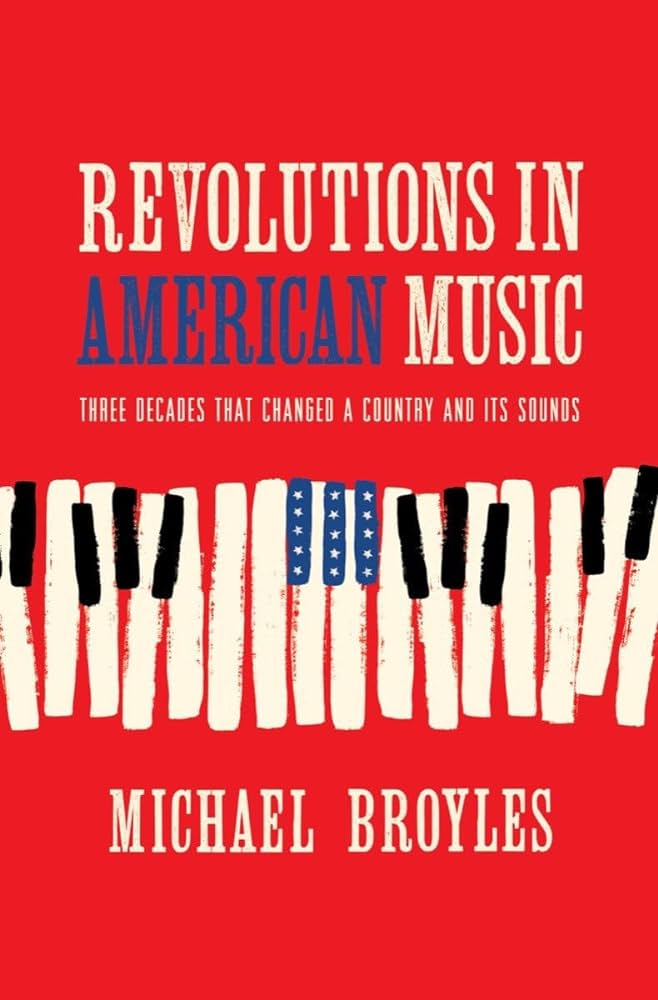
Michael Broyles believes three decades in American History profoundly changed American Music. The three key decades are the 1840s, the 1920s, and the 1950s.
I was most inthralled by Boyles’s presentation of the 1950s (except he cheats a little by making references to musical happenings in the 1940s).
“By 1945 many of the big bands had disbanded or were on life support, suffering from multiple blows caused by World War II. Gasoline rationing and a shortage of rubber made travel nearly impossible for an ensemble of twenty-plus musicians. Even staffing a band was difficult, with many musicians in the armed forces….
This bands that she how survived the war faced a new reality. The mood of the country had changed. The public no longer favors the jitterbugging, toe-tapping hot sound of Benny Goodman, but the fuller, heavier, she sound of Guy Lombardo or Freddy Martin….The public wanted to be soothed, and the big-three record companies, Columbia, RCA, and Decca, obliged. Sentimental Tin Pan Alley songs prevailed, sung by velvety singers with lush instrumental backing.” (p. 221)
In 1948, Columbia Records announced they will be issuing 33-1/3 rpm records in addition to 45 rpm records. Decca and RCA soon followed. Two more inventions, television and tape recorders, became powerful and essential tools to revolutionize both classical and popular music in the 1950s.
“Sam Philips, owner of Sun Records, allegedly said, ‘If I could find a white man who had the Negro sound and the Negro feel, I could make a billion dollars.'” (p. 253)
Sam Philips found Elvis Presley and the rest is History. Presley was the first Rock ‘n’ Roll superstar and changed the trajectory of popular music in the U.S. until the British Invasion in the Sixties.
Broyles makes the case that the 1840s introduced the minstrel show and the new dance craze, the polka, to America. It replaced the waltz and led to Sousa’s marches, then ragtime and ultimately Jazz.
The 1920s brought African American music into the music scene and Black musicians were able to make a living despite white singers covering their songs. Radio arrived and provided a new outlet for music. Phonographs became affordable and popular. Records in the 78 rpm format became common. “The 1920s blended race and technology to create the far-ranging changes in American musical culture, from creation to performance to audience, which was no longer limited to the soundscape of the event.” (p. 358)
If you have an interest in the History of music in America, I highly recommend Revolutions in American Music. GRADE: A
TABLE OF CONTENTS:
Introduction: A Personal Statement — xi
CHAPTER 1: Three pillars and the nature of revolution — 1
The 1840s:
CHAPTER 2: Minstrelsy : an American musical contribution and America’s curse — 13
CHAPTER 3: Polkamania and Polk — 46
CHAPTER 4: Classical music arrives. — 65
The 1920s:
CHAPTER 5: The twentieth century : music technology collapses time and space — 89
CHAPTER 6: The Jazz Age — 111
CHAPTER 7: Blues, hillbilly, and crooners — 149
CHAPTER 8: The ultramodern revolution and music appreciation. — 191
The 1950s:
CHAPTER 9: After the war — 221
CHAPTER 10: Johnnie Ray and the rise of rock ‘n’ roll — 241
CHAPTER 11: The summer of ’55 : rock ‘n’ roll’s turning point — 264
CHAPTER 12: Rock ‘n’ roll : culmination and collapse — 289
CHAPTER 13: Anonymity and its ways : classical music in a postwar world. — 320
EPILOGUE — 363
Notes — 365
Illustration Credits — 401
Index — 403
In the podcast I’ve mentioned before, “A History of Rock & Roll in 500 Songs”, host Andrew Hickey also credits two pre-WWII strikes with having a major influence on how post-war music developed. I can’t recall which one came first, but there was an orchestra musicians strike and a music publishers strike. The musicians strike led to radios playing recorded music rather than broadcasting live bands, and also emphasizing vocal performances in those live broadcasts, because the singers were not on strike. There was also the ASCAP songwriters strike, meaning any music published by ASCAP could not be played on the radio. Because ASCAP was the big publisher of what was then “mainstream” music, radio stations had to resort to playing music published by BMI, which at the time was considered a rather déclassé outfit, publishing blues, swing, country (i.e., poor people’s music, regardless of their race). This exposed listeners to regional & somewhat niche music that they would not have ordinarily heard on the radio. So even when the strikes were settled, people still wanted to hear those types of music and were chomping at the bit when rockabilly and rock & roll first arrived on the scene.
What Deb said. You really need to listen to this, George. He starts in the late ’30s with Benny Goodman and other precursors of rock & roll, goes through the Ink Spots and Louis Jordan among others in the ’40s. Very interesting stuff. Always listen to Deb!
Jeff, I always listen to Deb (and you and Patti and Steve and Jerry and Dan and Todd…). I’ll be listening to A HISTORY OF ROCK & ROLL in 500 SONGS soon.
Deb, Michael Broyles points out that the Big Band Era was damaged by World War II with rationing of gas (so travel was a problem) and many musicians left to fight in the war.
I am still hoping to get to the podcast Deb mentions. But I now have 30 some podcasts on my phone. So maybe a book is the way to go.
Patti, REVOLUTIONS IN AMERICAN MUSIC is a quick read with plenty of insights.
Champing at the bit!
Seems like new musical trends pop up every ten years! Unfortunately, that hasn’t stopped (C)rap from enduring! My theory is that it doesn’t require talent so would-be singers stick with it!
Bob, persistence is always a virtue in all walks of Life.